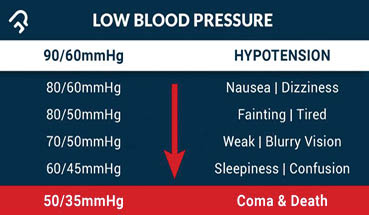Visual Guide to Low Blood Pressure
It isn’t just high blood pressure you should worry about. Your blood pressure can be too low sometimes for good health. It is called hypotension—when your readings are lower than 90 over 60. Symptoms. Your brain usually shows the first symptoms of hypotension. Besides dizziness and nausea, your spirits might be low, you might lack […]

It isn’t just high blood pressure you should worry about. Your blood pressure can be too low sometimes for good health. It is called hypotension—when your readings are lower than 90 over 60.
Symptoms. Your brain usually shows the first symptoms of hypotension. Besides dizziness and nausea, your spirits might be low, you might lack energy, and find it hard to think straight.
Some people feel lightheaded enough to faint or notice cold, clammy skin, faster breathing, blurry vision, or chest pain. If your low pressure is caused by dehydration, you also might feel unusually thirsty.
Wide vessels. Sometimes your blood vessels widen. That means there’s more space for blood to spread out, which puts less pressure on the walls of those vessels. Some drugs, especially a type called vasodilators, can cause this. So can spinal injuries that damage certain nerves, serious bacterial infections, and allergic reactions. Hormone problems like Addison’s disease, which weakens the adrenal glands, can also do it.
Less blood. Less blood means less pressure on your veins and arteries. An injury might cause you to bleed — either outside your body where you can see it, or inside. It might also happen if you don’t get enough to drink, your blood vessels leak fluid, or you have a blood condition called anemia. Sometimes your kidneys get rid of too much fluid because of illness or certain drugs, like diuretics.
Heart problems. The more blood your heart pumps per minute, the higher your blood pressure. Certain medications, along with hormone problems, heart damage, or misfiring electrical signals, can make your heart beat too slowly, which lowers that pressure. Or it could be that your heart is not as strong as it used to be because of a heart attack, heart failure, or problems with the valves, and so doesn’t pump as much blood per beat.
Quick and long. Normally when you stand suddenly, your body sends a signal to your brain that says “Hey! We just dropped a bunch of blood down to the legs and belly, and we need to pump some more back upstairs before you get dizzy and pass out!” But sometimes, your brain doesn’t get the message quickly enough and you start to feel lightheaded. You might even faint.
After you’re on your feet for a while, blood can start to pool in your legs. If your brain doesn’t tell your heart to pump enough to keep your blood pressure up, it might drop low enough to make you dizzy and nauseous. You might even pass out. Your doctor might call this “neurally mediated hypotension.” Like a bad relationship, the problem is poor communication, in this case, between the heart and brain.
Seek help. If you feel confused or notice fast, shallow breathing, a weak, rapid pulse, and cold, clammy skin, you may be in shock (extreme hypotension). Get to an emergency room right away. But lower blood pressure numbers, especially without other symptoms, aren’t usually a sign of a big problem. Talk to your doctor if you start to feel dizzy or lightheaded as well.
Courtesy WedMD
